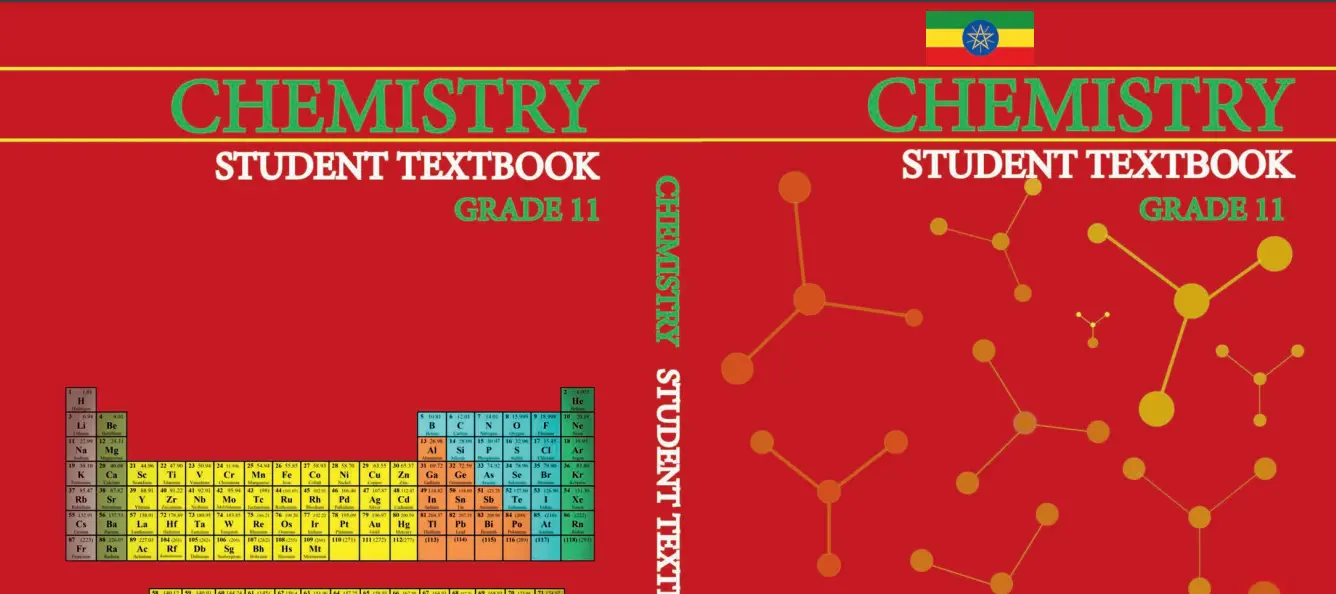Explore the newly published Ethiopian Grade 11 Chemistry textbook, authored by Tsegaye Girma, Abera Gure, and a team of experts. Discover the download link and dive into the world of chemistry education.
Ethiopian Ministry of Education Unveils New Chemistry Textbook for Grade 11
The Ethiopian Ministry of Education has recently released an updated Grade 11 Chemistry textbook that promises to revolutionize the way students learn about this fundamental branch of science. Authored by esteemed academics Tsegaye Girma, PhD, and Abera Gure, PhD, and meticulously curated by a team of editors, illustrators, designers, and evaluators, this textbook is a valuable resource for students seeking to excel in chemistry.
9 MB
Key Contributors to the Textbook
Before delving into the content, let’s acknowledge the individuals who have made this textbook a reality:
- Writers:
- Tsegaye Girma, PhD
- Abera Gure, PhD
- Editors:
- Chala Regasa, MSc (Content Editor)
- Taye Hirpassa, BSc., MA (Curriculum Editor)
- Meseret Getnet, PhD (Language Editor)
- Illustrator:
- Asresahegn Kassaye, MSc
- Designer:
- Daniel Tesfay, MSc
- Evaluators:
- Tolessa Mergo Roro, BSc., MEd
- Nega Gichile, BSc., MA
- Sefiw Melesse, MSc
Exploring the Book’s Contents
This Grade 11 Chemistry textbook is structured to provide students with a comprehensive understanding of the subject. Here’s a glimpse of its contents:
Chapter 1: Atomic Structure and Quantum Mechanics
1.1 Introduction
1.2 Dalton’s Atomic Theory and the Modern Atomic Theory
- Postulates of Dalton’s Atomic Theory
- Postulates of Modern Atomic Theory
1.3 Early Experiments to Characterize the Atom - The Discovery of the Electron
- Radioactivity and the Discovery of the Nucleus
- Discovery of the Neutron
1.4 Make-up of the Nucleus - Subatomic Particles
- Atomic Mass and Isotopes
1.5 Electromagnetic Radiation and Atomic Spectra - Electromagnetic Radiation
- The Quantum Theory and Photon
- Atomic Spectra
- The Bohr Model of the Hydrogen Atom
- Limitations of the Bohr Model
- The Wave-Particle Duality of Matter and Energy
1.6 The Quantum Mechanical Model of the Atom - The Heisenberg’s Principle
- Quantum Numbers
- Shapes of Atomic Orbitals
1.7 Electronic Configurations and Orbital Diagrams - Ground State Electronic Configuration of the Elements
1.8 Electronic Configurations and the Periodic Table of the Elements - The Modern Periodic Table
- Classification of the Elements
- Periodic Properties
- Advantages of Periodic Classification of the Elements
Chapter 2: Chemical Bonding
2.1 Introduction
2.1.1 The Octet Rule
2.1.2 Types of Chemical Bonding
2.2 Ionic Bonds
- Lewis Electron-Dot Symbols
- Formation of Ionic Bonds
- Exceptions to the Octet Rule in Ionic Compounds
- Properties of Ionic Compounds
2.3 Covalent Bonds and Molecular Geometry - Molecular Geometry
- Intermolecular Forces in Covalent Compounds
2.4 Metallic Bonding - Formation of Metallic Bonding
- Electron-Sea Model
- Properties of Metals and Bonding
2.5 Chemical Bonding Theories - Valence Bond (VB) Theory
- Molecular Orbital Theory (MOT)
2.6 Types of Crystal
Chapter 3: Physical States of Matter
3.1 Introduction
3.2 Kinetic Theory and Properties of Matter
- The Kinetic Theory of Matter
- Properties of Matter
3.3 The Gaseous State - The Kinetic Molecular Theory of Gases
- The Gas Laws
3.4 The Liquid State - Energy Changes in Liquids
3.5 The Solid State
Chapter 4: Chemical Equilibrium
4.1 Introduction
4.2 The Rate of a Reaction
4.3 Factors Affecting the Rate of a Chemical Reaction
Chapter 5: Organic Chemistry
5.1 Introduction
5.2 Chemical Equilibrium
- Reversible and Irreversible Reactions
- Attainment and Characteristics of Chemical Equilibria
- Conditions for Attainment of Chemical Equilibria
- Equilibrium Expression and Equilibrium Constant
- Applications of Equilibrium Constant
- Changing Equilibrium Conditions: Le-Chatelier’s Principle
- Equilibrium and Industry
Chapter 6: Organic Compounds
6.1 Introduction
6.2 Alcohols and Ethers
- Classification of Alcohols
- Nomenclature of Alcohols
- Physical Properties of Alcohols
- Preparation of Alcohols
- Chemical Properties of Alcohols
- Structure and Nomenclature of Ethers
- Physical Properties of Ethers
- Preparation of Ethers
- Reactions of Ethers
6.3 Aldehydes and Ketones - Nomenclature
- Physical Properties of Aldehydes and Ketones
6.4 Carboxylic Acids - Structure and Nomenclature of Carboxylic Acids
- Physical Properties of Carboxylic Acids
- Chemical Properties of Carboxylic Acids
- Preparation of Carboxylic Acids
- Fatty Acids
- Uses of Carboxylic Acids
6.5 Esters - Sources of Esters
- Nomenclature
- Physical Properties
- Chemical Properties
- Preparation of Esters
- Uses of Esters
6.6 Fats and Oils - Source of Fats and Oils
- Structure of Fats and Oils
- Physical Properties of Fats and Oils
- Hardening of Oils
- Rancidity
This Grade 11 Chemistry textbook is a valuable resource for students, educators, and anyone interested in expanding their knowledge of chemistry. Download the PDF today and embark on a journey of scientific discovery.





